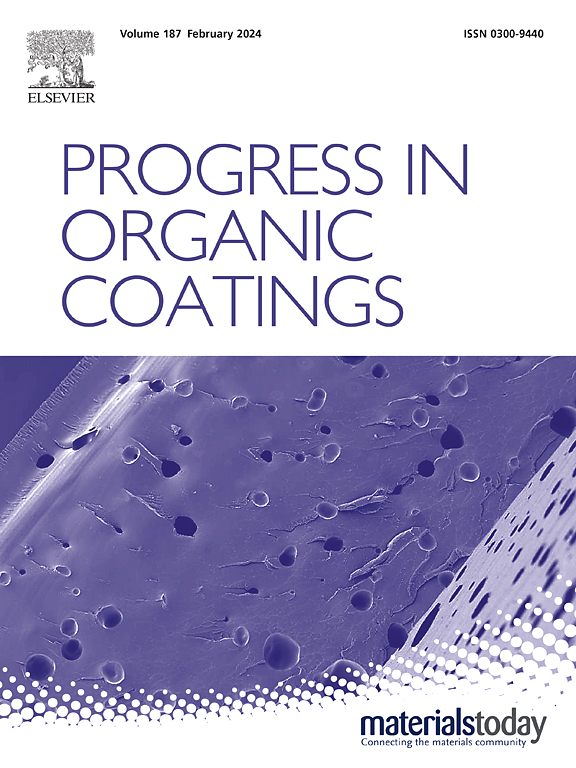仿生松香冰片环保防污涂料,具有自再生和自生成的两亲性表面
IF 6.5
2区 材料科学
Q1 CHEMISTRY, APPLIED
引用次数: 0
摘要
传统防污涂料中有毒和持久性物质的释放引发了大量的环境问题,强调了对环保替代品的迫切需求。本研究通过将可水解冰片修饰的两性离子前体DEA-IBOA接枝到生物衍生的松香树脂上,成功合成了一种环保的防污涂料,称为PSBZ-X-Y。通过改变DEA-IBOA改性松香的含量,可调节PSBZ-X-Y涂层的自更新率(50-400 μg/cm2·d),从而提高涂层的耐久性并调节冰片的释放。分子动力学(MD)模拟和表面结构分析(包括ATR-FTIR和XPS)表明,DEA-IBOA的水解导致天然抗菌药物冰片的释放,从而促进了两性离子表面的原位生成。两亲性表面和天然抗菌冰片作为生态友好的方法协同增强天然松香的防污性能,这反过来又促进了两亲性表面的可持续性,因为它的自我更新能力。因此,该涂层在实际海洋环境中表现出显著的抗蛋白质粘附(FITC-BSA粘附率:0.4%)、细菌生物膜形成(生物膜吸光度:1.3)和硅藻附着(150个细胞/mm2)的能力,以及显著的防污性能。更重要的是,在涂层更新过程中产生的水解产物对海洋生态系统没有不利影响,从而有助于基于天然产物的生态友好型防污系统。本文章由计算机程序翻译,如有差异,请以英文原文为准。
Bioinspired rosin-borneol eco-friendly antifouling coatings with self-renewable and self-generatable amphiphilic surface
The release of toxic and persistent substances in conventional antifouling paints has elicited substantial environmental concerns, underscoring an urgent requirement for eco-friendly alternatives. This study presents the successful synthesis of an eco-friendly antifouling coating, denoted as PSBZ-X-Y, through the grafting of a hydrolysable borneol-modified zwitterionic precursor, DEA-IBOA, onto a bio- derived rosin resin. The PSBZ-X-Y coating exhibits a controlled self-renewable rate (50–400 μg/cm2·d) tuned by varying DEA-IBOA modified rosin content, which enhances the coating's durability and regulates the release of borneol. Molecular dynamics (MD) simulations and surface structure analyses, including ATR-FTIR and XPS, reveal that hydrolysis of DEA-IBOA leads to the release of the natural antimicrobial agent borneol and thus facilitates the in-situ generation of zwitterionic surfaces. Amphiphilic surfaces and natural antimicrobial borneol as eco-friendly approaches synergistically enhance the antifouling properties of natural rosin, which in turn promotes the sustainability of amphiphilic surfaces due to its self-renewal capability. Consequently, the coating exhibits remarkable resistance to protein adhesion (FITC-BSA adhesion rate: 0.4 %), bacterial biofilm formation (absorbance of biofilm: 1.3), and diatom attachment (150 cells/mm2), as well as remarkable antifouling properties in real marine environments. More importantly, the hydrolyzed products generated during the coating renewal process demonstrate no adverse effects on the marine ecosystem, thus contributing to eco-friendly antifouling systems based on natural products.
求助全文
通过发布文献求助,成功后即可免费获取论文全文。
去求助
来源期刊

Progress in Organic Coatings
工程技术-材料科学:膜
CiteScore
11.40
自引率
15.20%
发文量
577
审稿时长
48 days
期刊介绍:
The aim of this international journal is to analyse and publicise the progress and current state of knowledge in the field of organic coatings and related materials. The Editors and the Editorial Board members will solicit both review and research papers from academic and industrial scientists who are actively engaged in research and development or, in the case of review papers, have extensive experience in the subject to be reviewed. Unsolicited manuscripts will be accepted if they meet the journal''s requirements. The journal publishes papers dealing with such subjects as:
• Chemical, physical and technological properties of organic coatings and related materials
• Problems and methods of preparation, manufacture and application of these materials
• Performance, testing and analysis.
 求助内容:
求助内容: 应助结果提醒方式:
应助结果提醒方式:


